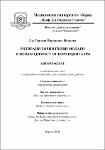I hereby declare that I will use the electronic library contents in compliance with COPYRIGHT AND RELATED RIGHTS ACT, Article 24, paragraph 1, item 9, only for scientific, cultural and educational purposes, without commercial gain, without commercial interest and non-profit.No Yes

Rotated Upper First Molars and Need for Correction /// Ротирани горни първи молари и необходимост от корекцията им

Date
2018Author
Ivanova, Gergana
Иванова, Гергана
gergana.ivanova@mu-varna.bg
Metadata
Show full item recordAbstract
The purpose of this dissertation thesis is to analyse the rotation of the upper first molars in the tooth arc and to establish the necessity of correcting it to achieve normal occlusal ratios. After research, analysis and evaluation of the results obtained, the following conclusions can be drawn: A significantly higher incidence of mediopalatine versus mediastinal rotation of UFM in mixed dentition has been established. To determine the weight of rotation of an UFM, it is necessary to use at least two angles indicators. There was a clear asymmetry in the magnitude of rotation between the right and left UFM, more frequent is the mediopalatine rotation to the left, and sexual dimorphism is present in Class II tooth-jaw deformations, and is more pronounced in girls There is a positive correlation between the heavier mediopalatine rotation and the following tooth-jaw deformations: in Class II tooth-jaw deformations (distal bite); with a shorter replaceable tooth arc; at a narrower intercanic distance; in case of overjet up to 4 mm. The premature loss of second temporary molars was found to be a major etiological factor for the occurrence of mediopalatine rotation of the UFM. There is a need for a different healing approach with varying degrees of severity of rotating the UFM. The slight degree of rotation in permanent dentition is favourably influenced by fixed technique, whereas heavy and asymmetric mean rotation require TPA or two-stage treatment. Целта на настоящия дисертационен труд е да се анализира ротацията на горните първи молари в зъбната дъга и да се установи необходимостта от коригирането й за постигане на нормални оклузални съотношения. След проведеното изследване, анализ и оценка на получените резултати могат да бъдат направени следните изводи: Установена е значително по-висока честота на медиопалатинална спрямо медиовестибуларна ротация на ГПМ в смесено съзъбие. За определяне тежестта на ротация на ГПМ е необходимо използването на най-малко два ъглови показателя. Установена е ясна асиметрия в големината на ротация между десните и левите ГПМ, като по-честа е медиопалатинална ротация в ляво и е наличен полов диморфизъм при клас II ЗЧД, като е по-силно изразена при момичета Установена е положителна зависимост между по-тежката медиопалатинална ротация и следните ЗЧД: при клас II ЗЧД (дистална захапка); при по-къса сменяема зъбна дъга; при по-тясно интерканиново разстояние; при наличие на овърджет до 4 мм. Установено е, че преждевременната загуба на вторите временни молари е основен етиологичен фактор за настъпване на медиопалатинална ротация на ГПМ. Установена е необходимостта от различен лечебен подход при различна степен на тежест на ротацията на ГПМ. Леката степен на ротация в постоянно съзъбие се повлиява благоприятно само с фиксирана техника, докато тежката и асиметричната средна ротация изискват прилагане на ТРА или двуетапно лечение.
